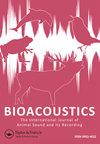Can you hear me now? A review of signal transmission and experimental evidence for the acoustic adaptation hypothesis
IF 1.5
4区 生物学
Q2 ZOOLOGY
Bioacoustics-The International Journal of Animal Sound and Its Recording
Pub Date : 2020-12-14
DOI:10.1080/09524622.2020.1858448
引用次数: 11
Abstract
ABSTRACT The Acoustic Adaptation Hypothesis (AAH) posits that animal acoustic signals used in long-range communication should be adapted to transmit well within the habitats in which they evolved. However, comparative studies of signal form indicate mixed support for predictions of the AAH. Several studies have employed experimental playback approaches to testing signal transmission which can complement comparative studies. Here, we summarise these experimental playback tests of the AAH in birds, mammals, insects, and anurans, we describe the methodologies used in these tests, and we assess the evidence for habitat-specific signal degradation and species-specific acoustic fidelity (i.e. whether signals propagate best in native versus foreign habitats). Experimental evidence, like comparative evidence, varies across habitats and taxa. Although transmission properties consistently differed by habitat, with closed habitats degrading signals more than open habitats, animal signals were not always adapted to propagate best within their native habitats. Researchers felt they had convincing evidence for species-specific acoustic fidelity in less than half of the 67 reviewed studies, with the most support found for birds and the least for anurans. We discuss potential explanations for differences within and between habitats and taxa and conclude with suggestions for standardised methodology and areas of future research.你现在能听到我说话吗?声学适应假说的信号传输和实验证据综述
摘要声学适应假说(AAH)认为,用于远程通信的动物声学信号应该适应在它们进化的栖息地内良好地传输。然而,对信号形式的比较研究表明,对AAH预测的支持率参差不齐。一些研究采用了实验回放方法来测试信号传输,这可以补充比较研究。在这里,我们总结了AAH在鸟类、哺乳动物、昆虫和无尾类动物中的实验回放测试,我们描述了这些测试中使用的方法,并评估了栖息地特异性信号退化和物种特异性声学保真度的证据(即信号是否在本地和外国栖息地传播最好)。与比较证据一样,实验证据因栖息地和分类群而异。尽管不同栖息地的传播特性一直不同,封闭的栖息地比开放的栖息地更能降解信号,但动物信号并不总是适合在其原生栖息地内最佳传播。研究人员认为,在67项审查的研究中,只有不到一半的研究有令人信服的证据证明了物种特异性的声学保真度,其中鸟类的支持率最高,无尾类的支持率最低。我们讨论了栖息地和分类群内部和之间差异的潜在解释,并提出了标准化方法和未来研究领域的建议。
本文章由计算机程序翻译,如有差异,请以英文原文为准。
求助全文
约1分钟内获得全文
求助全文
来源期刊
CiteScore
4.50
自引率
0.00%
发文量
25
审稿时长
>12 weeks
期刊介绍:
Bioacoustics primarily publishes high-quality original research papers and reviews on sound communication in birds, mammals, amphibians, reptiles, fish, insects and other invertebrates, including the following topics :
-Communication and related behaviour-
Sound production-
Hearing-
Ontogeny and learning-
Bioacoustics in taxonomy and systematics-
Impacts of noise-
Bioacoustics in environmental monitoring-
Identification techniques and applications-
Recording and analysis-
Equipment and techniques-
Ultrasound and infrasound-
Underwater sound-
Bioacoustical sound structures, patterns, variation and repertoires

 求助内容:
求助内容: 应助结果提醒方式:
应助结果提醒方式:


